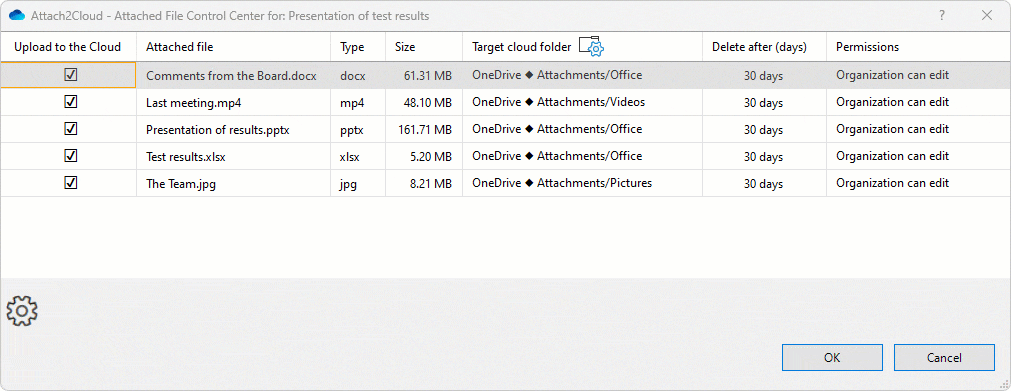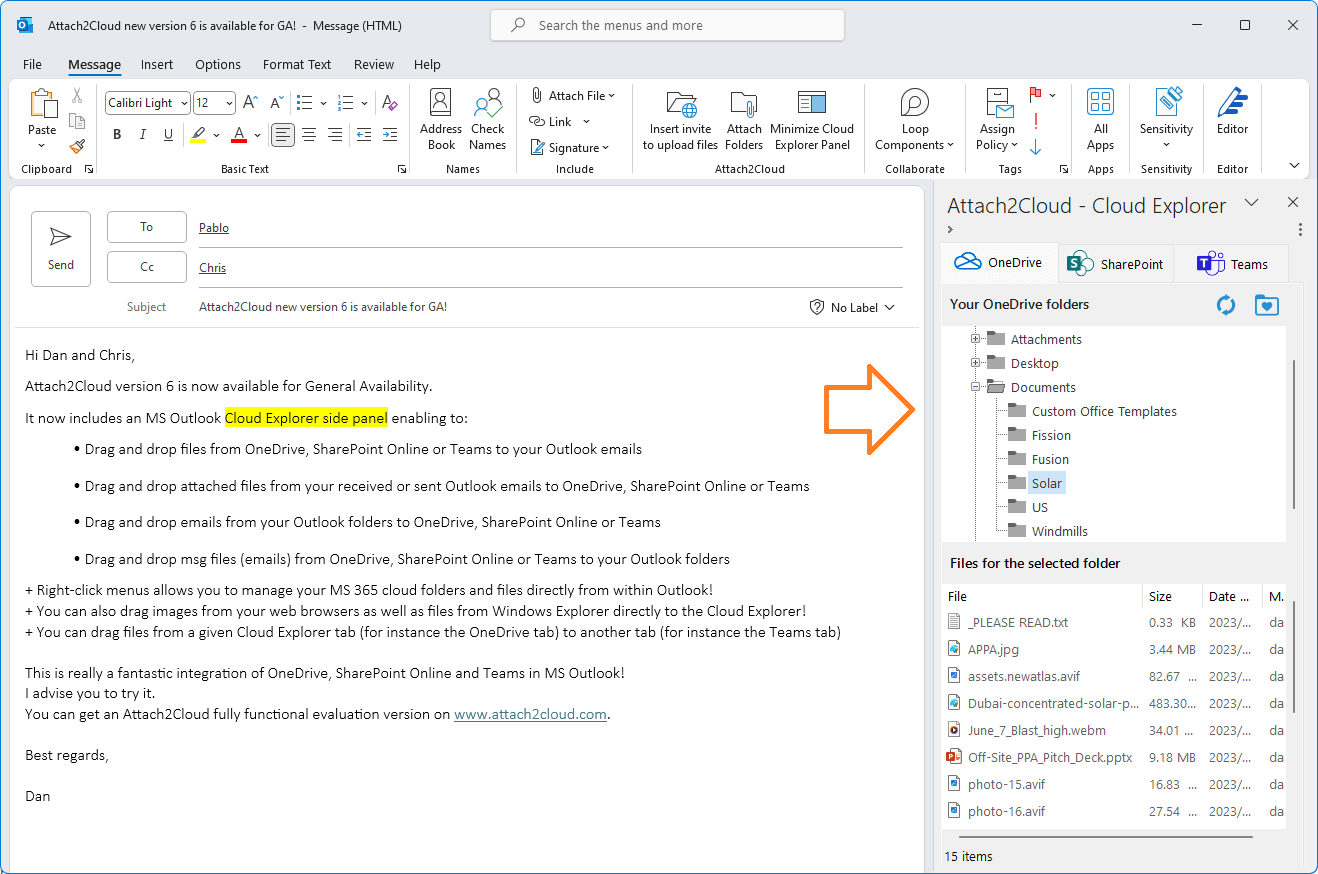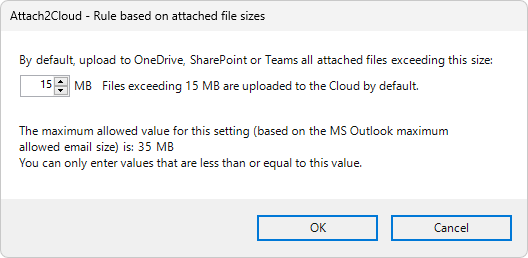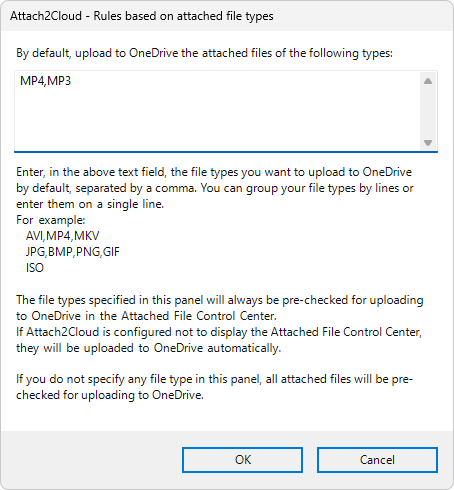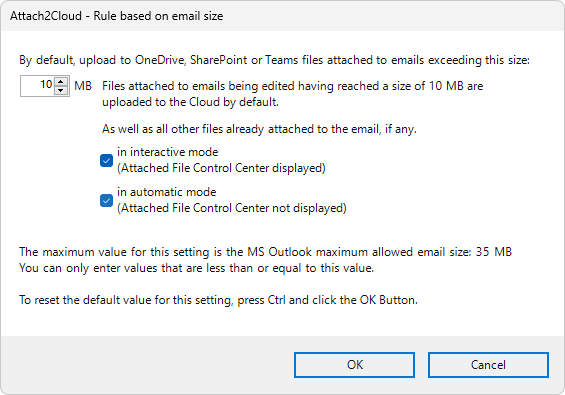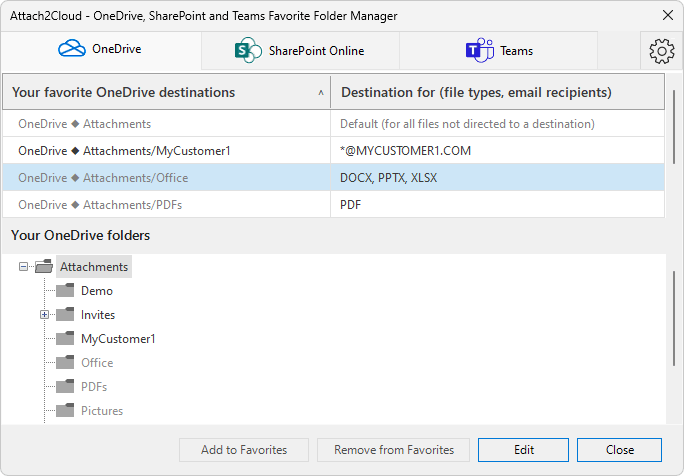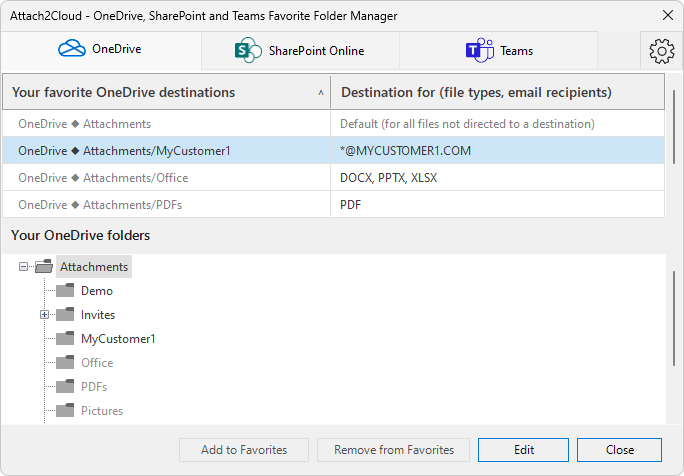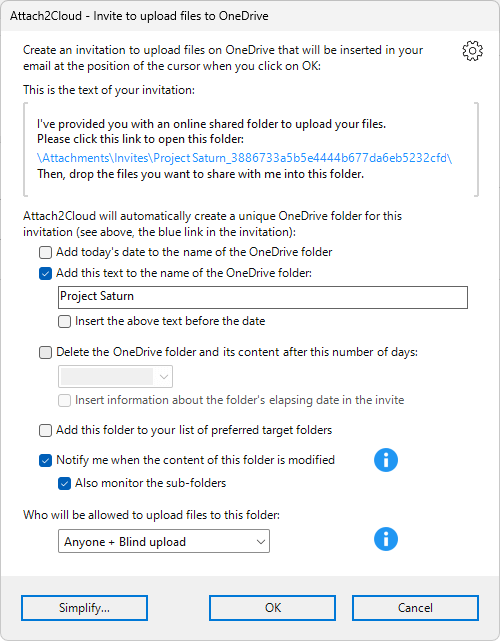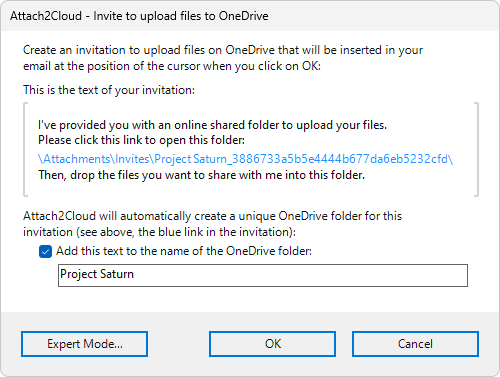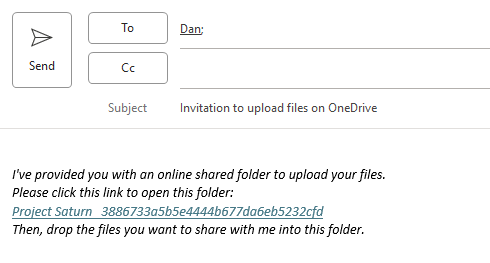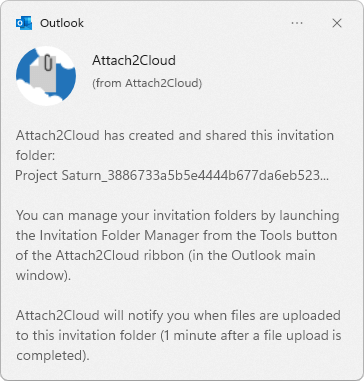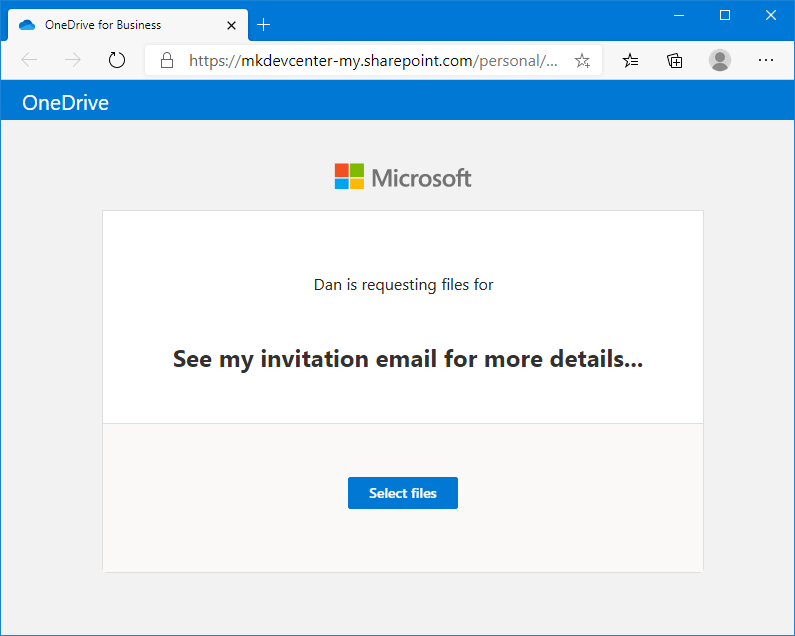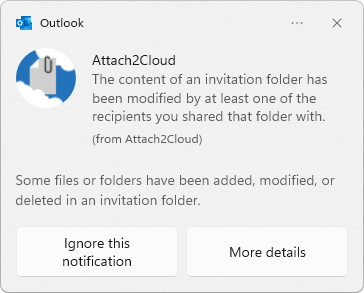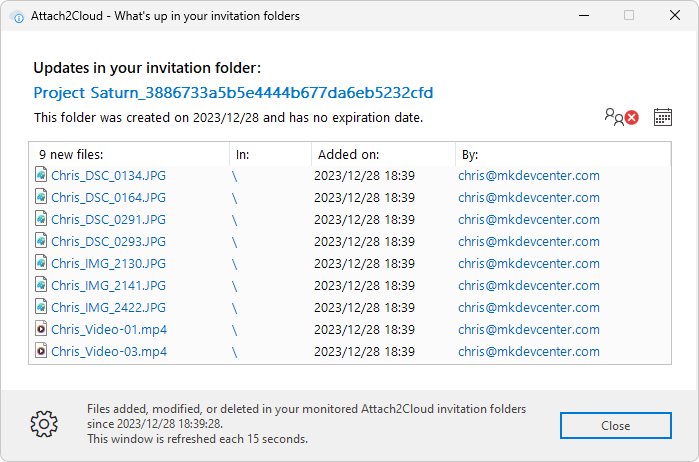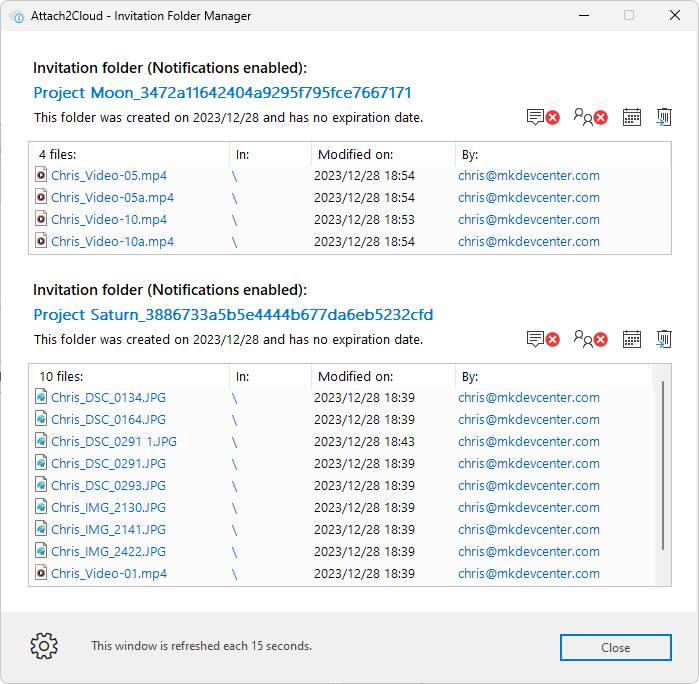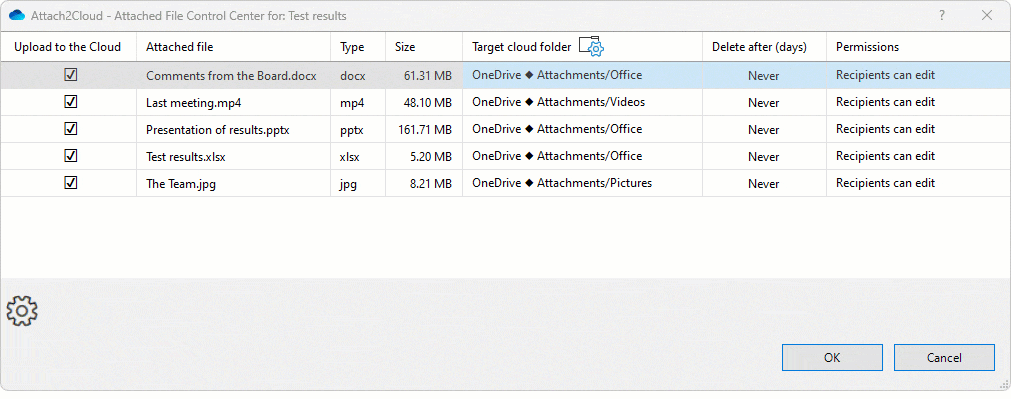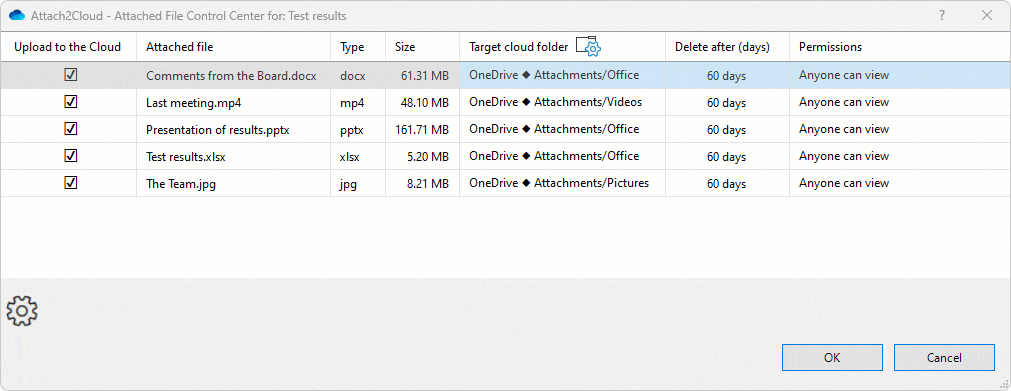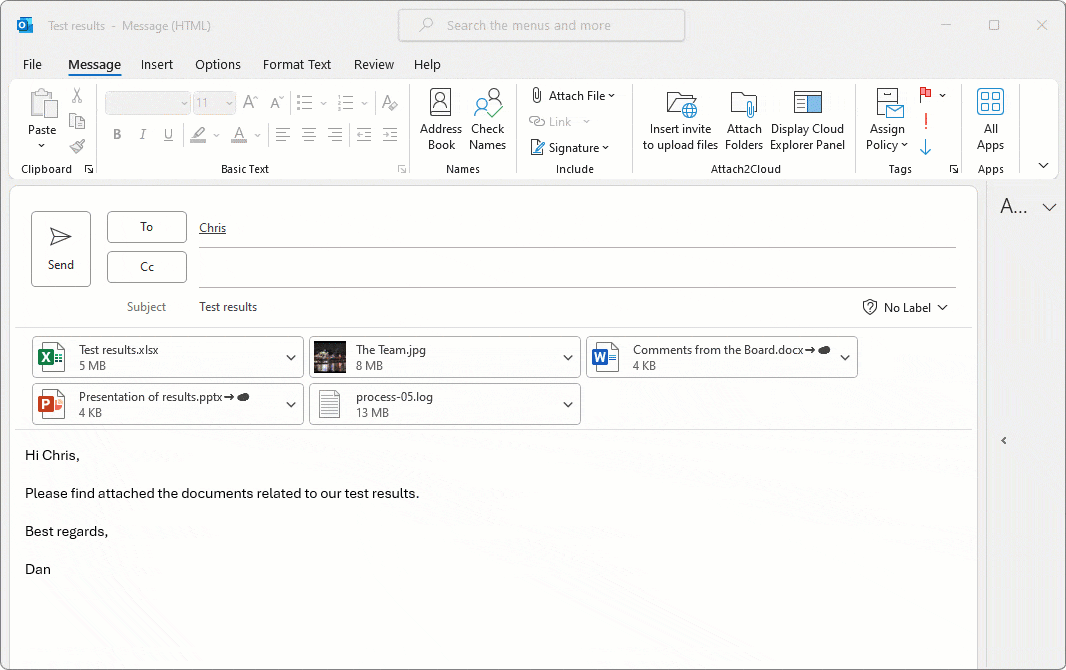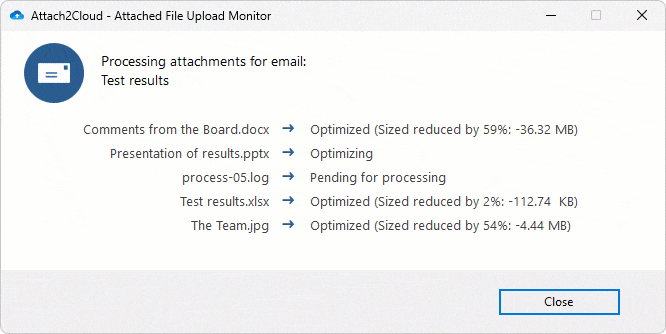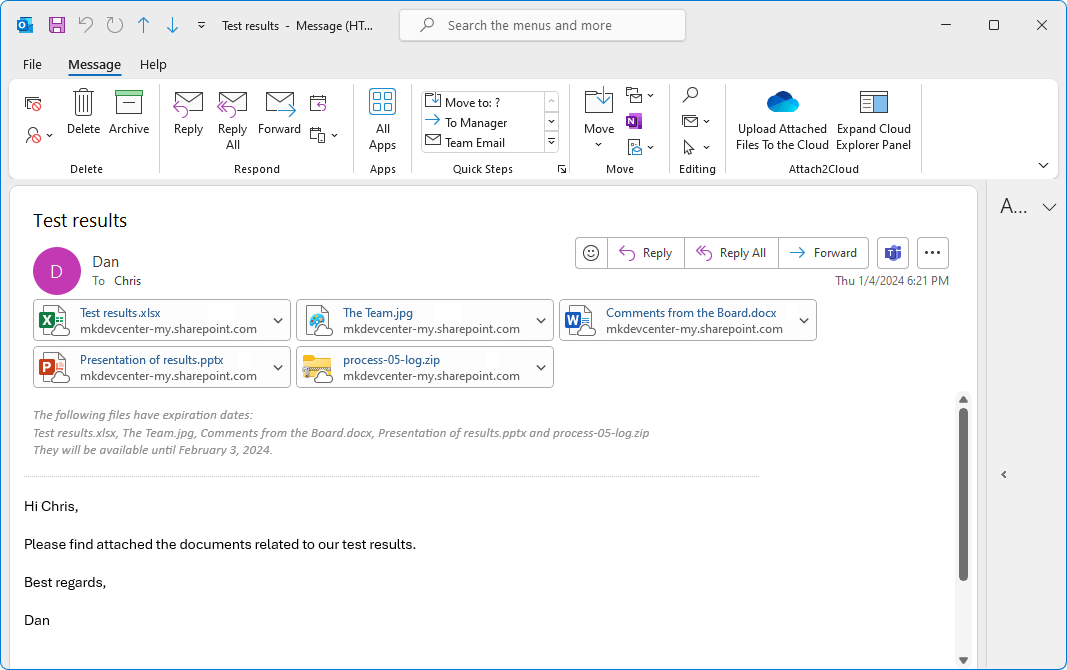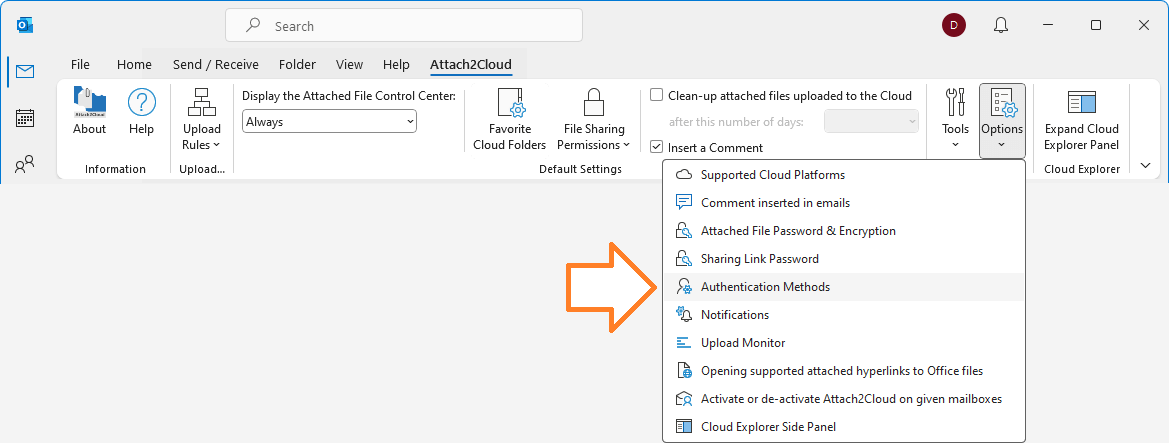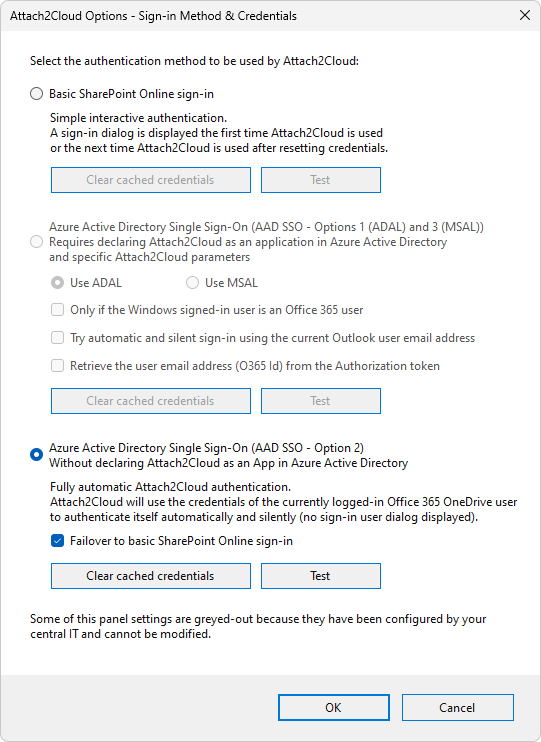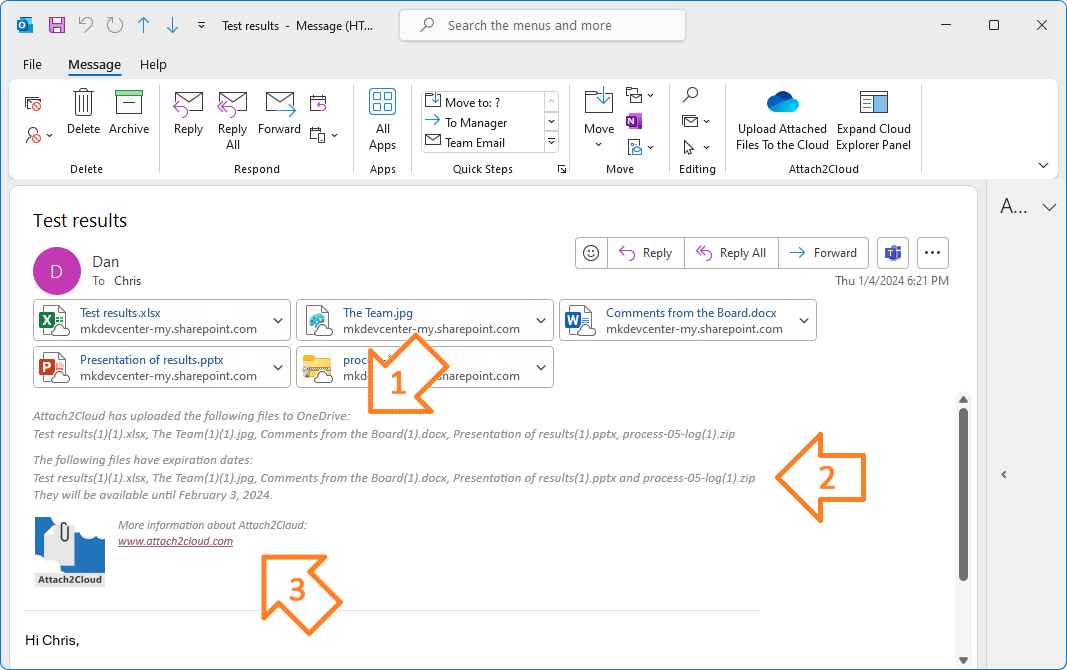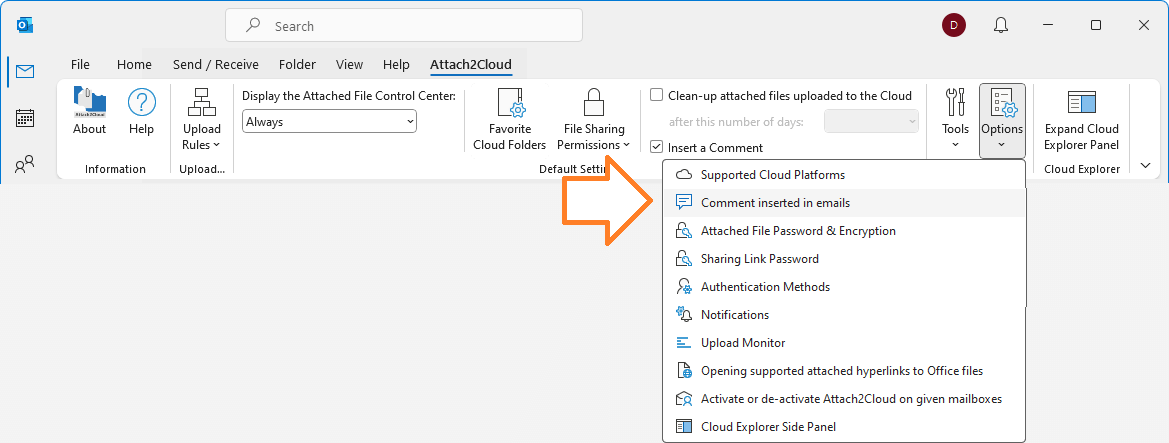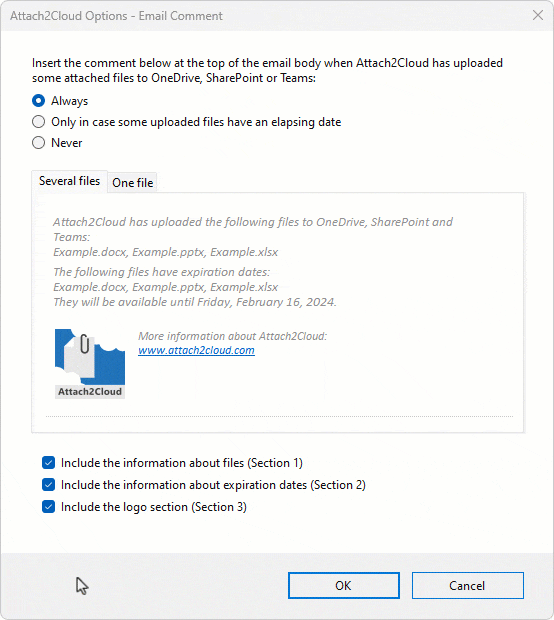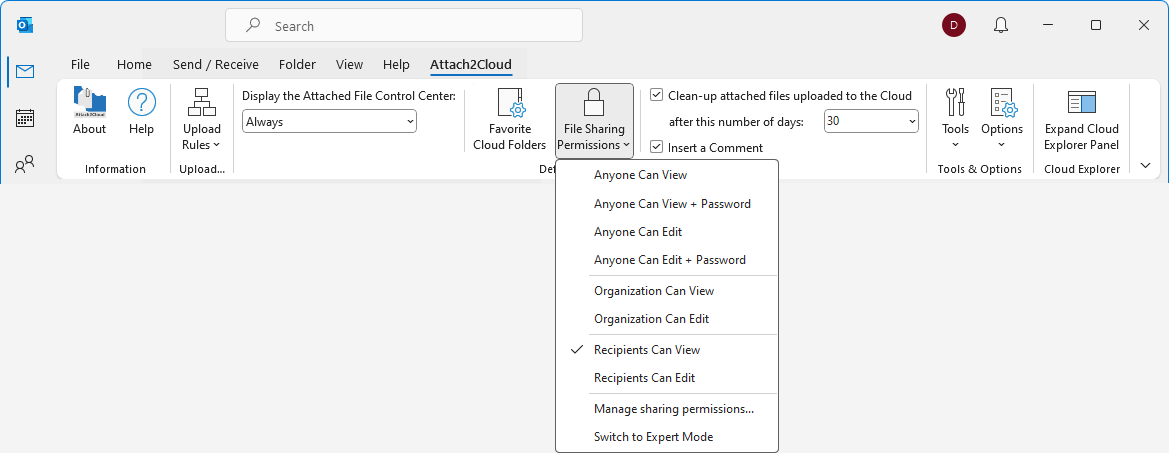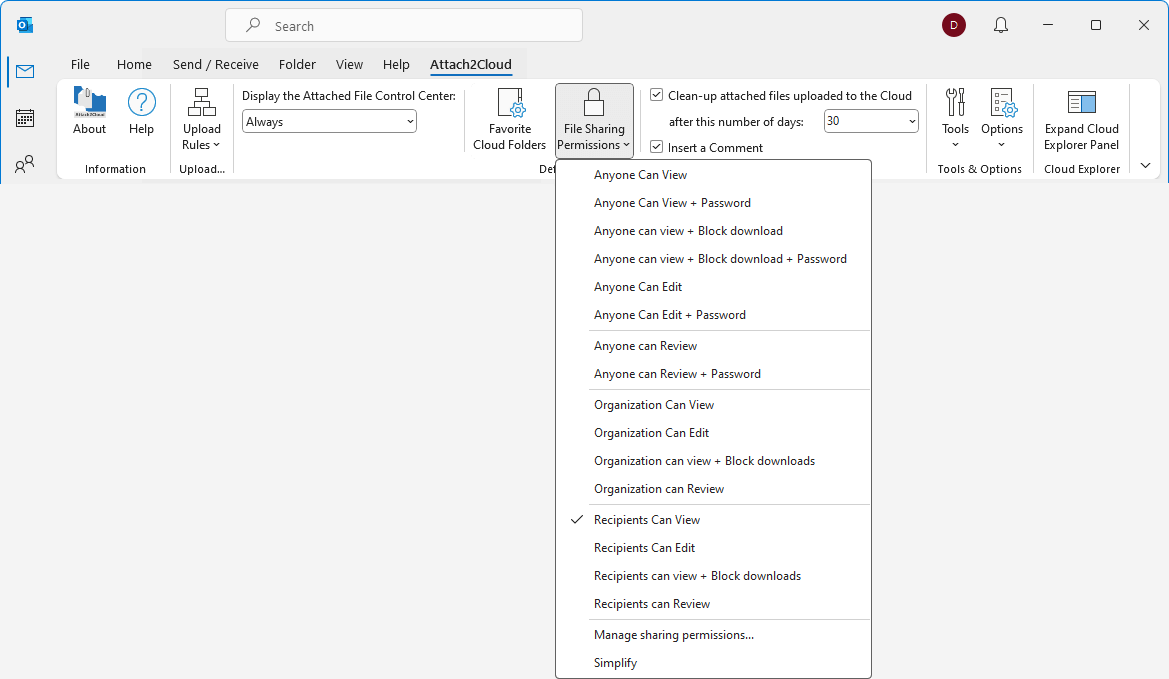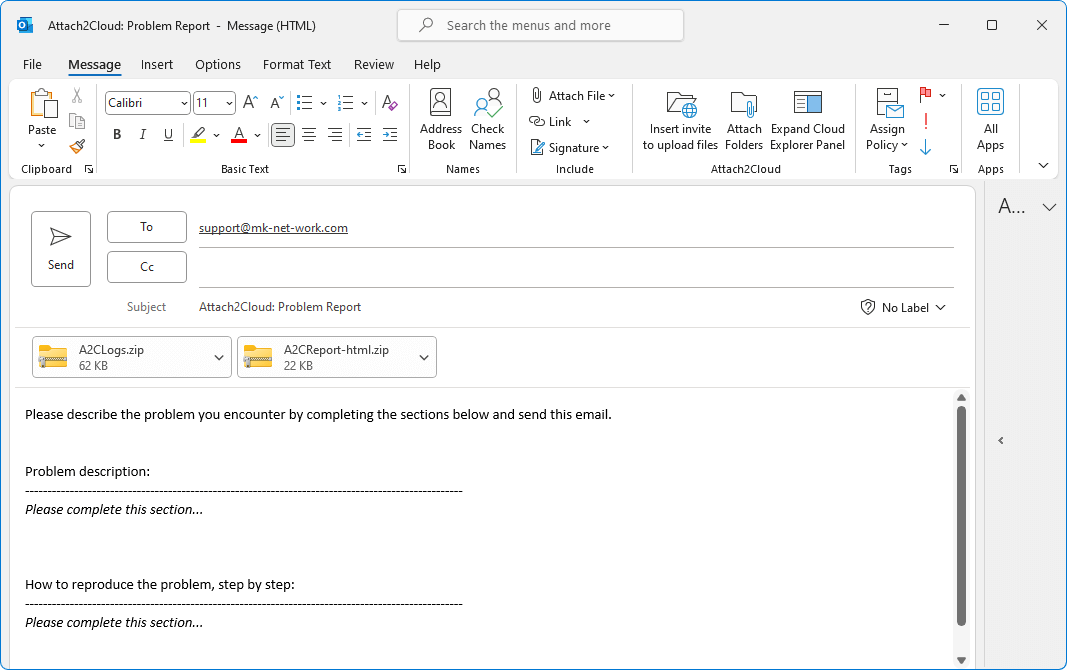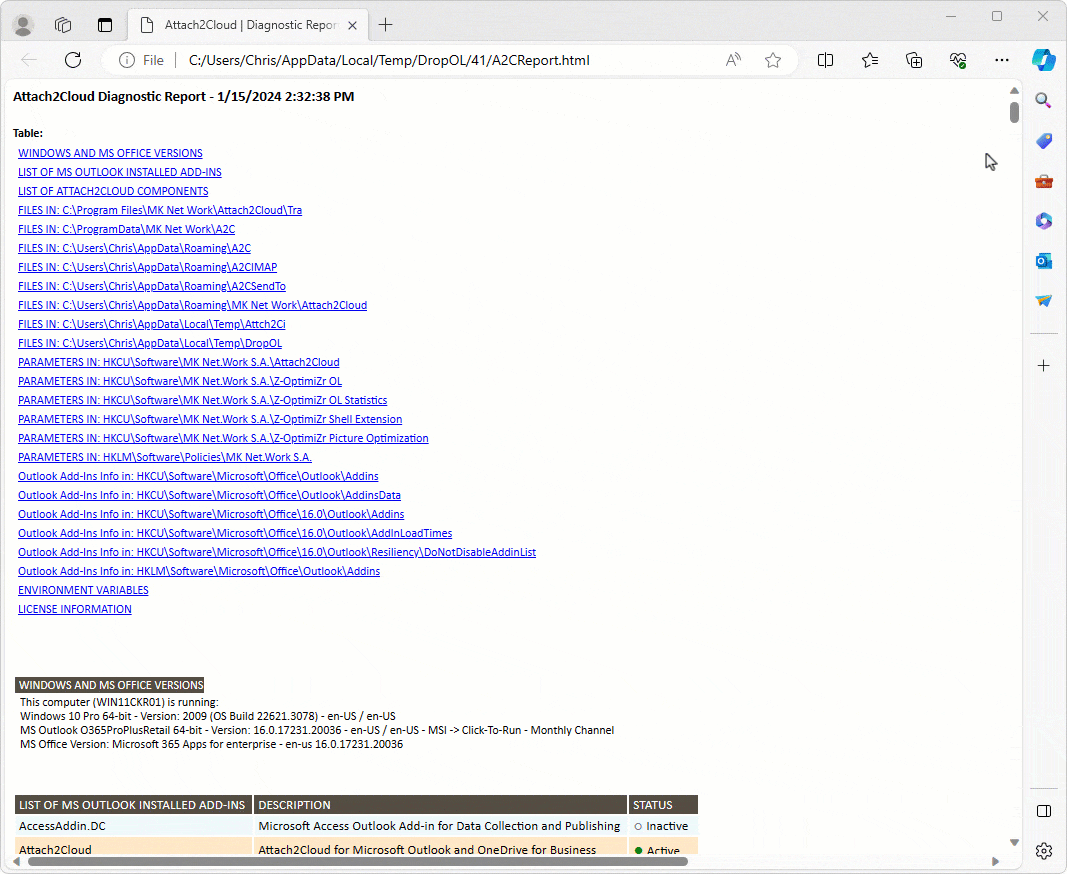
Attach2Cloud
Cloud Integration for Microsoft Outlook
Features
Attach2Cloud Features
About Attach2Cloud Features
The Attached File Control Center
Attaching large and extra-large files (up to 250 GB) to your MS Outlook emails
Attaching folders to your MS Outlook emails (and optionally securing them)
The upload monitor
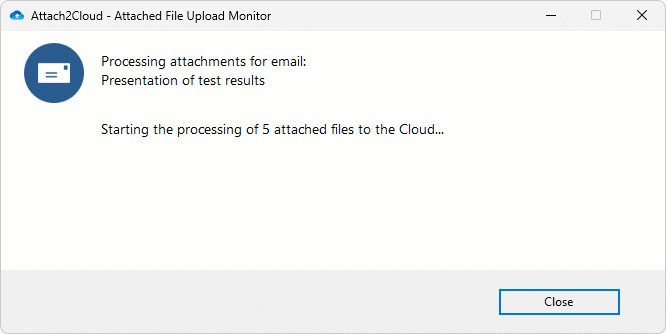
The Upload Monitor starts automatically when Attach2Cloud starts uploading attached files to the MS 365 cloud.
The Upload Monitor is fully asynchronous (like the attached file uploads). Thus, users can continue working in MS Outlook while the monitor is at screen and Attach2Cloud is uploading attached files. They can even send emails with attached files which Attach2Cloud will upload to the cloud during this time. Attach2Cloud will launch another instance of the monitor (and will give smaller files to upload (if any) higher upload priority).
Users can minimize or even close the Upload Monitor at any time, this does not affect the attached files uploads
The Upload Monitor closes itself automatically as soon as Attach2Cloud has completed the attached file uploads.
The Upload Monitor is optional. Users can use the Attach2Cloud ribbon (available in the main MS Outlook window) the Options button Upload Monitor menu, to configure Attach2Cloud not to display the Upload Monitor.
The Cloud Explorer for OneDrive SharePoint Online and Teams
The Upload Rules
Invitations to upload + The Invitation Folder Manager
Attaching files already in the Cloud to your emails
Saving files attached to received or sent emails to the Cloud
You can:
Save these attached files to the Cloud and replace them with Modern Attachments.
To do this, open the email to display it in an independent Outlook window.
Then click the Upload Files to the Cloud ribbon button in the default Message ribbon (in the Attach2Cloud button group):
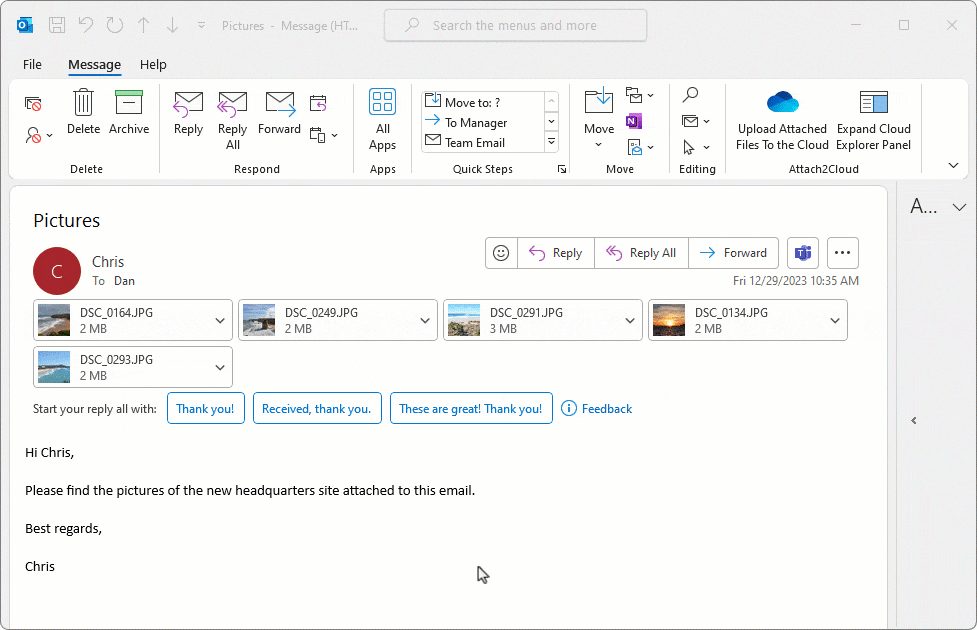
or
Save these attached files to the Cloud and keep them as classic attachments to your emails.
To do this, display the email and open or expand the Attach2Cloud Cloud Explorer side pane.
In this side panel, display the OneDrive, SharePoint Online or Teams folder into which you want to copy the files attached to your email.
Then, simply drag the attached files of your choice from your email and drop them to this target cloud folder.
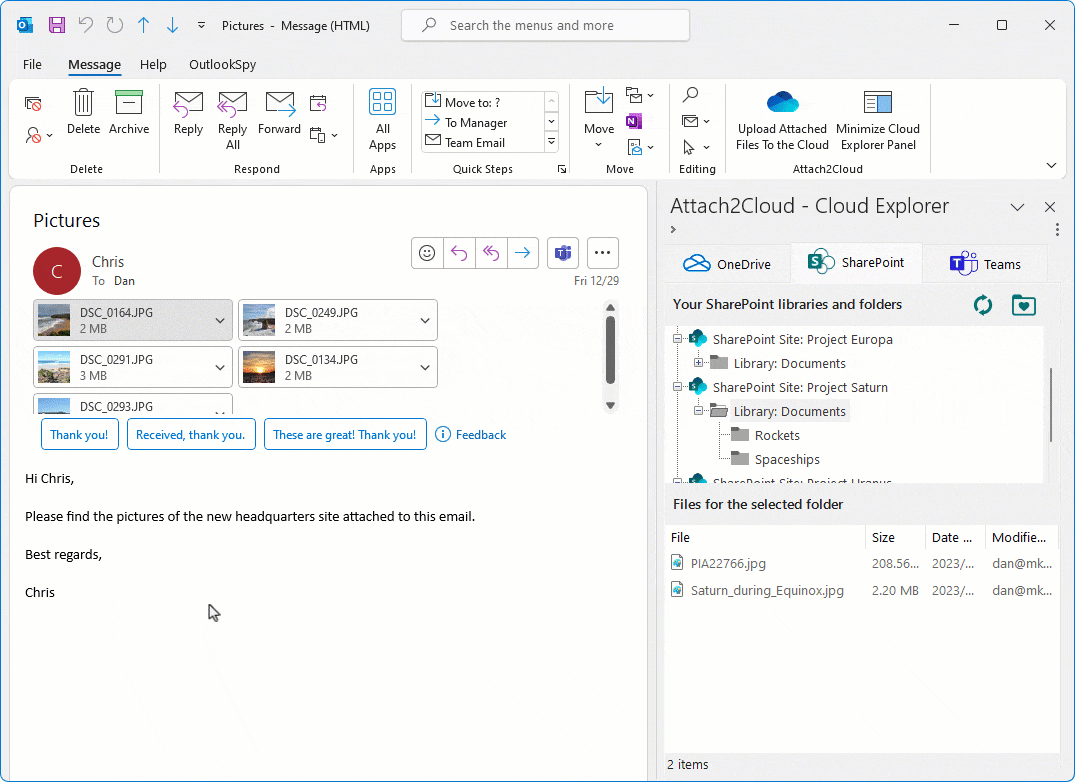
The Attach2Cloud ribbon in the main Outlook window
The Attach2Cloud button group in the Outlook message windows Message ribbon
Securing your attached files
Green IT Features: Attached file optimization and compression
Authentication options
Configurable comment inserted in sent emails having Attach2Cloud uploading their attached files to the Cloud
About Sharing Permissions
Problem Report
For the Attach2Cloud Administrators
Modern Attachment Previewer
Modern Attachment Previewer is our other cloud-integration add-in for Microsoft Outlook.
With Modern Attachment Previewer, you can Preview (and even edit in the Cloud!) your OneDrive, SharePoint Online and Teams cloud attachments, directly from within your MS Outlook emails!
Modern Attachment Previewer for Microsoft Outlook is the ideal companion of Attach2Cloud for Microsoft Outlook.
Both products can be bundled together into a single deployment package.
In the beginning
We delivered the very first version of Attach2Cloud in 2018, primarily for MS Outlook users new to the MS 365 cloud.
The initial aim of Attach2Cloud was to move MS Outlook users away from relying on classic attached files in favor of sharing files in the MS 365 cloud, without forcing them to change their habits.
With Attach2Cloud, MS Outlook users could continue attaching files to their emails, Attach2Cloud uploading them to the Cloud (initially OneDrive), sharing them with the email recipients and replacing them by Modern Attachments (shortcuts to cloud files), automatically or semi-automatically.
Then…
Since then, Attach2Cloud has continuously evolved in three directions:
- Extending the number of cloud-storage platforms covered. Initially limited to OneDrive, Attach2Cloud now also fully supports SharePoint Online and Teams.
- Engaging cloud-novice MS Outlook users to adopt the MS 365 cloud without changing their habits. (As per the initial goal of Attach2Cloud).
- Providing Microsoft Outlook with a unique set of powerful cloud integration features, covering the needs of the most advanced users.
For novice and up to the most advanced users
The latest version 6 of Attach2Cloud (optionally associated to Modern Attachment Previewer) fully integrates the MS 365 cloud in Microsoft Outlook.
Attach2Cloud and Modern Attachment Previewer provide MS Outlook with an incredible set of fully configurable cloud integration features, covering the needs of all types of users, from the most novice to the most advanced.
Not only are Attach2Cloud Features fully configurable (based on GPO-manageable registry parameters), but they can also be enabled / disabled or hidden (based on GPO manageable registry parameters), making Attach2Cloud suitable for the most diverse populations of users, including in a same company.
Automatic and Transparent
Although Attach2Cloud is likely to appeal to even the most demanding cloud users, what we are particularly proud of is that Attach2Cloud users don’t need to know about Attach2Cloud, read users manuals, or attend training sessions to take advantage of it.
Most of the Attach2Cloud features they need are made available to them automatically, when they need them, without them having to perform specific actions like finding and clicking buttons or menus.
No more MS Outlook email size limit!
Attach2Cloud allows attaching files up to 250 GB per file to your Microsoft Outlook emails (with no email size limit).
How?
Amazingly easy, you don’t have to do anything special, not even one single additional click!
Simply attach your large and extra-large files to your MS Outlook emails as usual using the MS Outlook paperclip button or dragging and dropping files or copy-pasting files to your emails.
Of course, these large files are never physically attached to your MS Outlook emails (and of course not even stored inside your local Outlook OST mail file, nor in your MS Exchange or MS Exchange Online server mailbox, even temporarily). But visually speaking, it is as if they were attached to your emails.
When you then send your emails, Attach2Cloud manages to transparently upload these large attached files to the Cloud (on OneDrive, SharePoint Online or Teams) in the background, then shares them with your email recipients, and replaces them by Modern Attachments (shortcuts to the uploaded files) before your email is sent.
You can continue working in MS Outlook and even send and receive emails while Attach2Cloud uploads and shares your attached files in the MS 365 Cloud.
Attach2Cloud puts and end to rejections of large emails
With Attach2Cloud, attaching your large files as Modern Attachments (shortcuts to cloud files), the size of your emails will never be larger than a few dozens of KB, whatever the size of the files you attach to them is.
This is the guarantee that your recipients will always receive them.
You can even attach entire folders to your emails
On top of allowing to attach exceptionally large files to your MS Outlook emails, Attach2Cloud also allows you to attach folders. Simply drag and drop folders from Windows Explorer to your MS Outlook email or click on the Attach folder button in the message ribbon. Attach2Cloud will zip them (including their subfolders if any) to a single Zip file and attach this Zip file to your email.
👉 More about Attaching large and extra-large files (up to 250 GB) to your MS Outlook emails…
Microsoft Outlook does not support attaching folders to emails
Even if Attaching folders to MS Outlook was an option, it would be of a moderate interest. Indeed, attaching large files is limited to the MS Outlook maximum allowed email size and, although Exchange Online admins can increase this limit, emails larger than 25 to 35 MB are rejected by most of the email servers.
But Attach2Cloud does!
Thanks to Attach2Cloud, you can now drag Explorer folders and drop them to your MS Outlook emails!
MS Outlook emails accept dropped folders with no question asked, and Attach2Cloud automatically attaches them to your emails under the form of a single Zip file.
Up to 250 GB per attached folder (after compression)!
Attach2Cloud allows attaching files up to 250 GB per file to your Microsoft Outlook emails (with no email size limit) and converts them automatically into Modern Attachments (OneDrive, SharePoint Online or Teams cloud files) when sending your emails.
Password-protect + encrypt your attached folders
You can also use the Attach Folders ribbon button in the Message ribbon to select one or more folders to attach to your emails.

Clicking the Attach Folders button displays a folder selection dialog including a Password checkbox.
If you tick this password checkbox, Attach2Cloud will display a password dialog when you validate the folder selection dialog.
If you enter a password in this dialog, Attach2Cloud will use the provided password to password-protect and encrypt the resulting Zip file attached to your email.
👉 More about Attaching folders (up to 250 GB after compression) to your MS Outlook emails…
How can users attach files to their MS Outlook emails as Modern Attachments?
When attaching OneDrive files taken from Windows Explorer OneDrive folders, Attach2Cloud can attach these files as Modern Attachments.
When using the Attach2Cloud Cloud Explorer side panel to drag and drop OneDrive, SharePoint Online or Teams files to emails, Attach2Cloud can attach these files as Modern Attachments.
When forwarding MS Outlook emails containing Modern Attachments.
When attaching a file to an email, then clicking the attached file icon, and selecting the Upload drop-down menu (this is an MS Outlook menu). (For information, in the Current Chanel Preview version of MS Outlook 365, using this menu results in attaching a link and not a Modern Attachment anymore. The future will tell if this “enhancement” will persist in the official version of MS Outlook 365).
What happens when sending emails containing modern attachments?
Attach2Cloud fully supports files attached to emails as Modern Attachments (files already stored in the Cloud).
In interactive mode:
When Attach2Cloud displays the Attached File Control Center (the window Attach2Cloud displays when you send emails containing attached files), Attach2Cloud lists all email attachments (classic and modern) in the Attached File Control Center and tags Modern Attachments with a cloud pictogram (allowing to distinguish them from classic attached files).
If the Attach2Cloud admins (or the user) have defined a default “Delete after n days” policy for the attached files shared in the Cloud by Attach2Cloud, Attach2Cloud does not apply this policy automatically to the Modern Attachments shared in their original cloud locations.
In automatic mode:
When Attach2Cloud does NOT display the Attached File Control Center when sending emails containing Modern Attachments), Attach2Cloud shares the attached cloud files in their current cloud location with the Recipients can view sharing permission. If the Attach2Cloud admins (or the user) have defined a default “Delete after n days” policy for the attached files shared in the Cloud by Attach2Cloud, Attach2Cloud does not apply this policy to the Modern Attachments shared in their original cloud locations.
What can Attach2Cloud do with Modern Attachments in the Attached File Control Center?
Attach them as classic attachments:
in the Attached File Control Center, you can ask Attach2Cloud to attach them as regular files (by unchecking the “Upload to the Cloud” checkbox) or to keep them as Modern Attachments (by keeping the “Upload to the Cloud” checkbox checked).
If the size of the attachment is such that attaching it to your email as a regular attachment is impossible (because the size of your email would in this case exceed the maximum size allowed for MS Outlook messages), Attach2Cloud will inform you.
Share them in their original location or copy them in another cloud location in order to share them here:
If you keep Modern Attachments attached as Modern Attachments, you can select (on a per file basis) a cloud destination other than their original cloud location. For instance, if the Modern Attachment is a OneDrive file, you can decide to copy it to another OneDrive folder or to a SharePoint or Teams destination.
If you do so, Attach2Cloud will execute a cloud-to-cloud copy of the file. The copy (for instance from OneDrive to SharePoint) will take place entirely in the Cloud. (Attach2Cloud will not download the file from OneDrive to the user’s PC then upload it to SharePoint). This is particularly interesting for large files because it is super-fast and saves network bandwidth.
Automatically delete them after a given number of days:
Like for classic attached files, you can specify a number of days after which Attach2Cloud must delete the shared cloud files.
For Modern Attached files shared in their original location, Attach2Cloud sets by default the “Delete After days” field to “Never”, even if Attach2Cloud is set to apply a specific default value (for instance 60 days). This to avoid deleting cloud files shared in their original location by accident.
Set their sharing permissions:
Attach2Cloud will check the user has the right to apply the selected sharing permission.
Manage the upload of your attached files when sending your emails
Attach2Cloud (by default) displays the Attached File Control Center window when you send emails containing attached files.

The Attach2Cloud Attached File Control Center enables you to take full control on the upload of your attached files to the Cloud (to OneDrive, SharePoint Online or Teams), on a per file basis.
For each of the attached files checked for upload, you can specify, on a per file basis:
- a cloud destination (on OneDrive, SharePoint Online or Teams)
- if Attach2Cloud must delete the uploaded file after a given number of days
- the sharing permissions for the file
Attach2Cloud (GPO-manageable) parameters enable to set default values for these options (possibly based on Attach2Cloud rules), to limit user choices for these options, or to lock these options to given values.
Continue working in Outlook while Attach2Cloud uploads your attached files to the Cloud…
When you validate the above Attached File Control Center window (by pressing OK), the email goes to the MS Outlook Outbox (like any other email being sent) and stays there while Attach2Cloud uploads the checked attached files to their cloud destinations, shares them with the recipients of your email and replaces them by Modern (cloud) attachments.
During this time, you can continue working in MS Outlook (and Attach2Cloud can optionally display its Upload Monitor).
You can even send new emails with attached files, Attach2Cloud will process them.
…and finally sends your email containing Modern (cloud) Attachments
Once Attach2Cloud finishes the attached file uploads, MS Outlook sends your email that now contains Modern Attachments (links to the uploaded cloud files shared with the recipients of your email as per the sharing permissions you specified in the Attached File Control Center).
Since the copy of the email stored in the MS Outlook Sent Items folder also contains these Modern Attachments, you and the recipients of your email can start working together on these cloud files if needed, and directly from Microsoft Outlook (see Modern Attachment Previewer).
Attach2Cloud can also work in fully automatic mode
It is also possible to configure Attach2Cloud NOT to display the Attached File Control Center by using the Display the Attached File Control Center combo-box in the Attach2Cloud ribbon available in the main MS Outlook window. (This option can also be managed and locked using GPO). In this case Attach2Cloud automatically uploads to the cloud all of the files attached to emails being sent:
Users can target files to be uploaded to the Cloud in automatic mode according to Attach2Cloud rules (on attachment size, e-mail size, file types or recipients). Users can configure these rules using the Attach2Cloud ribbon. Attach2Cloud administrators can also manage these rules via GPO and lock them if required.
Users can also specify default cloud destinations (if required, depending on file types or message recipients), default sharing permissions, and whether files uploaded to the cloud should be deleted after a certain number of days by default, using the Attach2Cloud ribbon. Attach2Cloud administrators can also manage these options via GPO and lock them if required.
Rules and default parameters also apply in interactive mode (when Attach2Cloud is set to display the Attached File Control Center). In this case, only the attached files targeted by the rules will be ticked for upload in the Attached File Control Center.
Since its version 6, Attach2Cloud includes a Cloud Explorer for Microsoft Outlook under the form of a (collapsible / expansible) Side Panel:
The Attach2Cloud V6 Cloud Explorer provides full support of bi-directional drag-drop between your MS 365 cloud storage spaces (OneDrive, SharePoint Online and Teams) and MS Outlook.
The Cloud Explorer right-click menus enable you to interact with, and manage your OneDrive, SharePoint Online and Teams files and folders, directly from Microsoft Outlook! You can now share, open, rename, and delete your MS 365 cloud files and folders, create new cloud folders, manage favorite cloud folders, and even more, right from Microsoft Outlook!
Because if fully integrates the MS 365 cloud in Microsoft Outlook, the Cloud Explorer is a key feature of Attach2Cloud.
It deserved a dedicated page providing all details:
By default, Attach2Cloud uploads all MS Outlook attached files to the Cloud
When users send emails containing attached files, Attach2Cloud displays (by default) the Attached File Control Center, a window into which users can tick the attached files they want to upload to the Cloud.
By default, Attach2Cloud ticks all attached files for upload and lets users free to untick the files of their choices, (provided unticking them does not make the email grow beyond the maximum allowed email size).
When Attach2Cloud is set not to display the Attached File Control Center window, by default, it uploads all attached files to the Cloud.
Make Attach2Cloud uploading MS Outlook attached files to the Cloud as per your own rules
Attach2Cloud upload rules allow to tune the way Attach2Cloud do ticks files for upload (in interactive mode, when displaying the Attached File Control Center) or directly uploads attached files (in automatic mode, when Attach2Cloud does not display the Attached File Control Center).
In interactive mode, not only do the upload rules tick the files they target, but they can also, based on GPO-manageable registry parameters), forbid users to untick them.
(In automatic mode there is no way for users not to upload the rule-targeted files to the Cloud).
Attach2Cloud provides six rule types
1. Rule to upload based on attached file size:
Tick for upload / Upload only attached files larger than a given size.
2. Rule to upload based on attached file types:
Tick for upload / Upload given attached file types
3. Rule to upload based on email size:
Tick for upload / Upload the attached files making the size of the email currently being edited exceeding a given size.
Optionally:
In interactive mode: if the rule ticks at least one attached file, tick them all.
In automatic mode: if the rule forces the upload of at least one attached file, upload them all.
4. Rule to set upload destination (on OneDrive) based on attached file types:
Upload attached files of given types to given OneDrive destinations. In interactive mode, users can select other destinations if the Attach2Cloud admins let them the right to do so.
5. Rule to set upload destination based on email recipients:
Upload files attached to email sent to given recipients or domains to given cloud destinations. In interactive mode, users can select other destinations if Attach2Cloud admins let them the right to do so.
6. Rule to deactivate Attach2Cloud for given recipients
Deactivate Attach2Cloud for emails sent to given recipients. If a given recipient is present in the list of the recipients of an email being sent, Attach2Cloud ignores the files attached to this email.
How to specify Attach2Cloud rules
Attach2Cloud Rules are GPO-Manageable registry parameters.
Like for most of the Attach2Cloud options, Attach2Cloud admins can let users free to create the rules they want by using the main MS Outlook window Attach2Cloud ribbon Rules menu and Favorite cloud folders button, and/or specify (and possibly lock, or partially lock) rules by using GPO-manageable registry parameters.
When creating rules, Attach2Cloud admins can set them as:
- Fully modifiable (and thus, cancelable) by users
- Not modifiable by users
- Partially modifiable by users
For example, Attach2Cloud admins can set a rule specifying that Attach2Cloud must upload attached files larger than 10 MB to the Cloud as a partially modifiable rule.
This means that users can modify the rule (using the Attach2Cloud ribbon Rules button), but only by setting a lower limit (for instance 5 MB instead of 10 MB). They cannot increase the limit nor remove the rule.
Attach2Cloud admins can also set the other rules as partially modifiable by users:
For the rule based on Attached file Types, Attach2Cloud admins can, for example, specify that Attach2Cloud must upload MP3, MP4, AVI and MKV to the Cloud and let users adding more file types if they want to, but not removing any of admin-specified file types.
For the rule based on email size, Attach2Cloud admins can set a rule specifying that Attach2Cloud must upload attached files making emails grow in excess of 15 MB to the Cloud and let users free to lower this limit.
For the rule setting upload destinations based on attached file types, Attach2Cloud admins can set a policy specifying cloud destinations for given file types, for example uploaded Office attached files must go to OneDrive Attachments/Office, image files to OneDrive Attachments/Images, PDF files to OneDrive Attachments/PDF etc. and let users adding new policies or specifying other destinations for their files but forbidding them to remove the admin-specified cloud destinations from the list of favorite cloud destinations.
For the rule setting upload destinations based on email recipients, Attach2Cloud admins can specify given <cloud destination, email recipient> couples while letting users free to add more such couples but forbidding them to remove any of the admin-specified ones).
The rule deactivating Attach2Cloud for given recipients can only be specified by Attach2Cloud admins via GPO-Manageable registry parameters. There is no Attach2Cloud UI enabling users to manage this rule that remains under the sole responsibility of the Attach2Cloud admins.
Setting rules using the main Outlook window Attach2Cloud ribbon Upload Rules button
The Upload Rules button and menu:
Setting the rule based on attached file size:
Setting the rule based on attached file types:
Setting the rule based on email size:
Setting rules using the main Outlook window Attach2Cloud ribbon Favorite Cloud Folders button:
The Favorite Cloud Folders button:
Using the Favorite Cloud Folder Manager
to specify attached file cloud destination based on attached file types:
Using the Favorite Cloud Folder Manager
to specify attached file cloud destination based on email recipients:
Invite other people to upload files to your OneDrive storage space
When writing your emails, click on the “Insert invite to upload file” ribbon button to display the Attach2Cloud invitation composer panel enabling you to create an invitation to upload files to your OneDrive storage space. Attach2Cloud will insert the resulting invitation in your email (at the cursor position) when you validate this panel.
Attach2Cloud invitations are very convenient, particularly when you need to collect large files (too large to be sent by email) from other people, even if they do not belong to your organization and do not have OneDrive.
The invitation composer panel
The invitation composer panel supports an Expert Mode and a (fully configurable) Simplified Mode.
Attach2Coud Administrators can configure the Simplified Mode to include only a subset of the Expert Mode options and set the default values of their choice for the other (hidden) options.
They can allow users to switch between Expert and Simplified modes, and even allow users to configure their own Simple Mode.
This is the Attach2Cloud invitation composer panel when configured in Expert Mode:
And this is the Attach2Cloud invitation composer panel in the simplest possible Simplified Mode:
As you can see, most of the options displayed in Expert Mode are hidden in Simplified Mode, making the creation of an invitation even quicker.
For the options hidden in Simplified Mode, default values set by Attach2Cloud admins apply.
Example of an invitation inserted to an email after completing and validating the above invitation panel:
Sending the invitation
When sending your email, Attach2Cloud will automatically create the invitation folder in your OneDrive storage space and share it with the recipients of your email, as per the sharing permission you specified (or set by default if hidden) in the invitation composer panel.
(If you finally cancel and do not send your email, Attach2Cloud will not create any invitation folder in your OneDrive storage space).
Attach2Cloud displays this notification when an email containing an invitation is sent:
Back to the invitation sender
The invitation sender receives notifications when the recipients of his/her invitation upload files to the invitation folder.
Clicking on the “More details” notification button
Clicking on the “More details” notification button displays the list of the new files the invitation recipients have uploaded to the invitation folder since the last time the user clicked on More Details:
Manage your invitation folders with the Attach2Cloud Invitation Folder Manager
The Attach2Cloud Invitation Folder Manager enables you to manage your invitation folders.
You can launch it by displaying the Attach2Cloud ribbon in the main Outlook window and clicking on the Tools / Invitation Folder Manager menu:
This is the Invitation Folder Manager window:
The Attach2Cloud Invitation Folder Manager enables you to display the files uploaded by the recipients of your invitations (locally or in the browser), to open the invitation folders (locally or in the browser), to enable or disable notifications related to given invitation folders, to stop sharing given invitation folders, to modify their elapsing date and to delete them.
Clicking on the email address of a file uploader creates and opens a new email addressed to him/her.
The Attach2Cloud ribbon is fully configurable
Attach2Cloud admins can use GPO-manageable parameters to hide ribbon controls, set default values for each control and even lock or limit given option value ranges.
The Attach2Cloud ribbon button group in the MS Outlook message windows in edit mode:
This is the default configuration of the Attach2Cloud ribbon button group:
This is the configuration of the Attach2Cloud ribbon button group with the optional Prioritize Attach2Cloud button untoggled:
This is the configuration of the Attach2Cloud ribbon button group with the optional Prioritize Attach2Cloud button toggled:
The Attach2Cloud ribbon button group is fully configurable
Attach2Cloud admins can use GPO-manageable parameters to hide or show the Attach2Cloud ribbon buttons available in the MS Outlook message windows (and to pre-set the status (toggled – untoggled) of the optional Prioritize Attach2Cloud button).
More details about the Attach2Cloud buttons available in edit mode

The Insert invite to upload files button
This button is available when writing emails.
Clicking this button displays a dialog enabling you to compose an invitation to upload files to OneDrive and to insert it into your email, at the cursor position.

The Attach Folders button
This button is available when writing emails.
Clicking this button displays a folder selection dialog enabling the user to select folders to attach to the email. (Attach2Cloud will Zip the selected folders into a single Zip file and attach this resulting Zip file to the email when you validates the folder selection dialog). The folder selection dialog includes a “Password” checkbox, enabling you to password-protect + encrypt the resulting Zip file.

The Display / Expand / Minimize Cloud Explorer Panel button
This button is available when writing emails and when reading emails.
It enables you to manage the visibility of the Attach2Cloud Cloud Explorer side pane.
Attach2Cloud updates its caption dynamically based on the status of the Cloud Explorer side pane.

The Prioritize Attach2Cloud toggle button
This toggle button is available when writing emails.
Contrary to the other buttons, Attach2Cloud does not display this button by default. (Displaying it requires Attach2Cloud admins to set a GPO-manageable registry parameter).
Toggling this button forces Attach2Cloud to upload the files attached to the email after you toggled the button.
In the case of other MS Outlook add-ins processing attached files when sending emails, toggling this button before you attach files to a given email may give priority to Attach2Cloud, and thus, to the upload of the email attachments on OneDrive.
Un-toggling this button lets Attach2Cloud decide which files attached to the email after you untoggled the button it must upload to the Cloud (possibly based on upload rules).
The Attach2Cloud ribbon button group in the MS Outlook message windows in read mode:
The Attach2Cloud ribbon button group is fully configurable
Attach2Cloud admins can use GPO-manageable parameters to hide or show the Attach2Cloud ribbon buttons available in the MS Outlook message windows.
More details about the Attach2Cloud buttons available in read mode

The Upload Attached Files to the Cloud button
This button is available when reading emails containing classic attached files.
Clicking this button displays the Attach2Cloud Attached File Control Center enabling the user to select the files to upload to the Cloud, their target cloud destination, optionally, their sharing permission and, optionally, how long the uploaded files must be kept (by setting a number of days after which Attach2Cloud must delete the files uploaded to the Cloud). When the user validates the Attached File Control Center, Attach2Cloud uploads the selected attached files to the Cloud and replaces them with Modern Attachments (links to cloud files).

The Display/Expand/Minimize Cloud Explorer Panel button
This button is available when redacting emails and when reading emails.
It enables the user to manage the visibility of the Attach2Cloud Cloud Explorer side pane.
Attach2Cloud updates its caption dynamically based on the status of the Cloud Explorer side pane.
Attach2Cloud provides two ways to secure your attached files:
Password based encryption of attached files and shared link password protection.
Password-based encryption of MS Outlook attached files
In the Attach2Cloud Attached File Control Center, (the window Attach2Cloud displays when you send emails with attached files), you can display the Secure your files panel.
If you do not see it, click the option (dented wheel) button, like in the video below.

If you tick this panel checkbox, Attach2Cloud will ask you for a password and will use this password to password-protect and encrypt your attached files (into Zip containers) after you validate the Attached File Control Center window.
Password protection and file encryption also work with the attached files you do not upload to the Cloud (attached files having the Upload to the Cloud checkbox un-ticked in the Attached File Contorl Center).
The Attach2Cloud password protection and file encryption use by default the standard Zip encryption format. This means that the recipients of your password-protected + encrypted Zip files do not need Attach2Cloud to decrypt them.
For example, Windows Explorer manages to display a password dialog when double-clicking on such files and is able to decrypt them (provided the user enters the good password).
Attach2Cloud can also support (based on GPO manageable registry parameters) the Zip AES 256 encryption format.Zip AES 256 is a less widespread standard than the standard Zip encryption. For example, although it is supported by most of the major Zip premium utilities, Windows Explorer does not support it.
Attach2Cloud can decrypt Zip AES 256 attached files when saving them on disk or when opening them and includes Windows Explorer extensions enabling to decrypt Zip AES 256 files in Windows Explorer.
We can also provide a Windows utility able to decrypt Zip AES 256 files produced by Attach2Cloud.
Attach2Cloud admins can enforce password rules (like minimum number of letters, numbers, special characters, and minimum password length) through GPO-manageable parameters. They can also allow Attach2Cloud users to edit these rules through the Attach2Cloud Ribbon Options button Attached File Password & Encryption menu.
Attach2Cloud processes the encryption of your attached files in the background (like for the upload of your attached files to the Cloud). You can continue using Outlook during this time.
The optional Attach2Cloud Upload Monitor also monitors the encryption of your attached files.
As a side benefit, Attach2Cloud makes password protected and encrypted files smaller, thanks to the Zip compression.
If you are interested in the reduction of the size of your MS Outlook attached files, please see the Green IT section of this page about attached file optimization and compression.
Attach2Cloud native optimization for MS Office and Image files reduces the size of these files without zipping them. The optimized files remain in their original format and can be consumed by their associated applications.
Attach2Cloud also supports state of the art Zip compression for files other than MS Office and image files which cannot be optimized natively.
• Please note:
The password-based encryption feature requires the optional Z-OptimiZr extension module (which also provides the attached file native optimization for MS Office and image files and the Zip compression features to Attach2Cloud).
You need to add this optional Z-OptimiZr module on the top of your Attach2Cloud Enterprise subscription (it is a paid add-on) to make the Secure your files panel available in the Attached File Control Center.
Shared links password protection
Another way to secure access to your uploaded MS Outlook Attached files is to password-protect their sharing links. You can do this in the Attach2Cloud Attached File Control Center (the window Attach2Cloud displays when you send emails with attached files) by selecting a sharing permission supporting the + Password option.
If you do so, Attach2Cloud will ask you for a password when you validate the Attached File Control Center window and will protect the link to the uploaded file with this password.
Password protecting link is provided by SharePoint Online and can only apply to these sharing permissions:
- Anyone can view
- Anyone can edit
- Anyone can review
(This permission can only be set to Docx files)
This is the reason the + Password option is only available for these permissions in the Attached File Control Center combo list of sharing permissions.
As a side note, you can customize the combo list of sharing permissions by using the Manage sharing permissions… menu at the bottom of this list.
AAttach2Cloud can significantly contribute to your Green IT strategy
By automatically transitioning your MS Outlook users from exchanging attached files to sharing files in the Cloud:
Attach2Cloud, by uploading Microsoft Outlook attached files to the Cloud, saves huge amount of MS Exchange storage space:
- Attached files sent to multiple recipients are stored one single time in the Cloud compared to as many times as recipients + one time for the sender for classic attached files.
- The sender and the recipients of the files work on a single cloud copy of the original attached files (that is versioned incrementally) instead of emailing back and forth modified copies of attached files to all of the recipients of the original email.
On millions or billions of attached files, this already makes a very significant difference in terms of amount of storage space consumed. These massive storage space savings translate in electric energy consumption and carbon footprint reductions.
But Attach2Cloud can do even more: reducing the size of your MS Outlook attached files by 40% to 60% on average:
Thanks to the Z-OptimiZr extension module, Attach2Cloud can reduce the size of your MS Outlook attached files by 40% to 60% on average.
The Z-OptimiZr extension module can optimize MS Office and image files natively. This means these files are made smaller without being zipped.
The optimized files remain in their original format (docx, pptx, xlsx, jpg, png…) after optimization and can be consumed by their associated applications.
The recipients of the optimized files do not need Attach2Cloud to consume them, and, since the Z-OptimiZr optimization fully preserves their rendering quality, their recipients won’t even realize the files have been optimized.
And for the files other than MS Office and image files that cannot be optimized natively, Z-OptimiZr can Zip-compress them.
MS Outlook Attached file Optimization and Compression
In the Attach2Cloud Attached File Control Center, (the window Attach2Cloud displays when you send emails with attached files), you can display the Z-OptimiZr panel.
If you do not see it, click the option (dented wheel) button, like in the video below.

To activate the native optimization and or the compression of your email attached files, simply tick the corresponding checkboxes in this panel (they may be ticked by default depending on Attach2Cloud settings).
Optimization and compression also work with the attached files you do not upload to the Cloud (those for which the Upload to the Cloud checkbox is not ticked in the Attached File Control Center).
Attach2Cloud displays the optimization and compression checkboxes based on your email attached files. For example, if there is no MS Office file in the list of your attached files, the Optimize MS Office files checkbox is not displayed.
Attach2Cloud will optimize and / or compress your attached files after you validate the Attached File Control Center window. Attach2Cloud optimizes and compress the files in the background, like for the upload of your attached files to the Cloud. You can continue working in MS Outook during this time.
Attach2Cloud admins can configure the default status of the Z-OptimiZr panel (visible / hidden) as well as the default status of the optimization and compression checkboxes in this panel (ticked / unticked) using GPO parameters.
They can also permanently hide any of the optimization or compression checkboxes, for example letting only the native optimization checkboxes available but not the Zip compression checkbox.
Attach2Cloud processes the optimization and the compression of your attached files in the background (like for the upload of our attached files to the Cloud), while your email remains in the MS Outlook Outbox.
You can continue using Outlook during this time.
As you can see in the video below, the optional Attach2Cloud Upload Monitor also monitors the optimization and the compression of your attached files and informs you of the volume reductions achieved (individually for each attachment, as well as in total, for all attachments).
Attach2Cloud automatically added the comment about the attached file expiration dates at the top of the email body. This is an option that can be managed from Attach2Cloud ribbon in the main Outlook window Insert a comment checkbox and Options / Comment inserted in emails menu.
The Attach2Cloud native optimization software layer implemented in the Attach2Cloud Z-OptimiZr extension module comes from our Z-OptimiZr and ZipMail product lines. For more information about native optimization for MS Office files and image files, you can have a look at these pages on our smallerfaster.com web site:
The Attach2Cloud optimization and compression features are provided by the optional Z-OptimiZr extension module (which also provides attached file attached file optional password-based encryption).
You need to add (license) this module on the top of your Attach2Cloud Enterprise subscription to make the Z-OptimiZr panel available in the Attached File Control Center.
Attach2Cloud of course fully supports Azure Active Directory Single Sign-On (AD SSO) and Multi-Factor Authentication (MFA).
By default, Attach2Cloud uses the MS Outlook current credentials, thus, there is nothing special to do to make Attach2Cloud AD SSO and MFA compliant.
Customers can also declare Attach2Cloud in Azure as an Azure application. We have a PowerShell script to do this declaration automatically.
This script also retrieves the newly declared application Ids and other parameters, encrypts them, and generates a .Reg file containing the necessary Attach2Cloud parameters, ready to be imported in the registry for testing purposes.
Attach2Cloud admins at the customer can then propagate these parameters via a GPO (using the Attach2Cloud ADMX file if necessary) or ask us to propagate them to their installed Attach2Cloud users through an Attach2Cloud online update.
We can also insert these parameters into the customer’s Attach2Cloud setup package. (The Attach2Cloud Enterprise subscription includes the Attach2Cloud setup package customization service at no additional cost).
The Attach2Cloud ribbon in the Main MS Outlook window provides an Options / Authentication Methods menu displaying this panel:
This panel allows to select the Attach2Cloud authentication method among the available ones. If the Azure AD Attach2Cloud application parameters (mentioned above) are not present in the registry, the second option is unavailable (greyed out), like in the above screenshot.
This panel is mainly useful for testing purposes, or to help resolve authentication issues. It also allows to clear the Attach2Cloud cached credentials. In rare circumstances, clearing Attach2Cloud cached credentials can also help resolving authentication issues.
Like for most of the Attach2Cloud options, Attach2Cloud admins can hide the Attach2Cloud ribbon Options / Authentication Methods menu, and if not, lock selected authentication options so that users cannot modify them.
Attach2Cloud can insert a configurable comment at the top of the body of emails for which it has uploaded attached files to the Cloud.
As you can see in the screenshot below, this comment is composed of 3 sections:
Section 1: Information about the fact some or all of the files attached to the email are Modern Attachments (attachments in the Cloud).
Section 3: An area intended to provide a logo and/or a link (by default, the Attach2Cloud logo and the link to the attach2cloud.com web site).
As for the other Attach2Cloud ribbon controls, the Attach2Cloud admins can configure Attach2Cloud to show or hide this checkbox and set its default value using GPO manageable registry parameters.
As for the other Attach2Cloud ribbon controls, the Attach2Cloud admins can configure Attach2Cloud to show or hide this menu and specify the Attach2Cloud comment properties using GPO manageable registry parameters.
- Select which sections of the comment Attach2Cloud must insert. Each time the user ticks or unticks a section checkbox, it updates the real-time preview of the comment.
- Insert the comment only in case some of the email attached files Attach2Cloud has uploaded to the Cloud have elapsing dates.
- Switch off or on the insertion of the comment (this will update the Insert a comment checkbox in the Attach2Cloud ribbon accordingly.
Attach2Cloud Enterprise customers can provide us with a logo, a text, and a link to display in the logo section (section 3) of the comment.
We will provide them in return with an encrypted file containing the corresponding customized section 3.
We can include this file in their custom Attach2Cloud setup package and distribute it through a silent Attach2Cloud update to their Attach2Cloud installed users.
Attach2Cloud supports all OneDrive and SharePoint Online file sharing permissions:
Anyone Can View
Anyone Can View + Password
Anyone Can View + Block Downloads
Anyone Can View + Block Downloads + Password
Anyone Can Edit
Anyone Can Edit + Password
Anyone Can Review
Anyone Can Review + Password
Organization Can View
Organization Can View + Block Downloads
Organization Can Edit
Organization Can Review
Recipients Can View
Recipients Can View + Block Downloads
Recipients Can Edit
Recipients Can Review
If SharePoint Online admins made some sharing permissions unavailable to MS 365 users in the SharePoint Online admin center, these permissions will of course also be unavailable in Attach2Cloud.
Additionally, the Attach2Cloud admins can remove any permission from the Attach2Cloud sharing permission list using GPO-manageable registry parameters.
Attach2Cloud users can select their preferred default permission for file sharing in the MS Outlook main window Attach2Cloud ribbon File Sharing Permissions drop down menu (see screenshot below). (Attach2Cloud admins can also hide this control and / or lock the default sharing permission using GPO-manageable parameters).
Attach2Cloud offers 2 different views on the available file sharing permissions through an Expert and a Simplified mode. Users can switch between these two modes depending on their needs. Typically, the Simplified mode listing only the basic sharing permissions can be used by default, while the Expert mode listing all of the available sharing permissions can be used on demand for particular needs.
Users can configure their own Expert and Simplified modes provided the Attach2Cloud admins let them the right to do so. Else, Attach2Cloud admins can configure the Simplified and Expert modes containing only the permissions of their choice (and let Attach2Cloud users the right to modify them or not) or keep only one single mode listing the sharing permissions of their choice. (All this by using GPO-manageable registry parameters).
This is the list of permissions available by default in Simplified mode (see at the bottom of the list, the Manage sharing permissions and Switch to Expert Mode menus):
And this is the list of permissions available by default in Expert mode (see at the bottom of the list, the Manage sharing permissions and Switch to Simple Mode menus):
Attach2Cloud displays similar Expert and Simplified mode permissions combo-lists (including the Manage sharing permissions and Switch to Simple Mode menus) in the Attached File Control Center (the window Attach2Cloud displays when sending emails containing attached files).
Something does not work as expected?
Simply send a problem report using the main Outlook window Attach2Cloud ribbon Tools / Report a Problem menu.
- Generate an HTML report containing all the data related to Attach2Cloud and to the user system context (active and inactive Outlook add-ins, Attach2Cloud registry parameters, Outlook add-in registry parameters, list of Attach2Cloud components with their versions, Windows and Outlook versions, Windows environment variables…)
- Collect the Attach2Cloud log files and internal parameter files.
- Zip compress and attach the HTML report and the collected files to a new email and open this email (addressed to the Attach2Cloud support team) in edit mode, letting you complete the short form it contains (and, if needed, checking the attached elements).
Attach2Cloud Problem Reports are real time-savers, both for you and for the Attach2Cloud support team.
No more time lost collecting informations about the Attach2Cloud user context we could ask you in order to be able to analyse a problem. You can send all the needed data directly to the Attach2Cloud support team, in one single click!
Attach2Cloud administrators can configure Attach2cloud to add one or more recipients to the emails containing these problem reports (e.g. their own Attach2Cloud internal support service) using a GPO-manageable registry parameter (encrypted by us beforehand).
This is the Problem Report email generated when clicking on the Attach2Cloud ribbon Tools / Report a Problem menu:
This is the HTML report attached to the above Problem Report email as A2CReport-html.zip:
The Attach2Cloud value proposition also covers Attach2Cloud administrators:
All-inclusive Attach2Cloud Subscriptions
Attach2Cloud is offered through all-inclusive subscriptions including software, services, updates, and unlimited access to the Attach2Cloud support for the Attach2Cloud administrators (by phone and by email).
No administration of Attach2Cloud users is required, all is automatic:
- Attach2Cloud users are created automatically and on the fly at first run (no user dialog).
- Software activation is automatic (no user dialog, no license keys to manage).
- Attach2Cloud user count is managed automatically. Inactive users are automatically removed from the customer Attach2Cloud user count.
No repackaging of your Attach2Cloud setup package is needed:
Do you want to configure Attach2Cloud to match your internal policies and preferences?
Simply ask us to integrate the corresponding registry parameters into your Attach2Cloud setup package. Your Attach2Cloud settings are stored in our Attach2Cloud customer database and persist for your next setup package deliveries (updates and new versions).
Online software updates and online parameter updates
Would it be to deploy Attach2Cloud updates and new versions, or to update one or more Attach2Cloud parameters, you can ask us for an online update of your installed Attach2Cloud user base.
Except if specified otherwise, Attach2Cloud online updates are only performed upon customer’s approval (and, if needed, after a preliminary test update applied successfully to a test group of users).
Consolidated usage statistics
Are you curious to know how many files Attach2Cloud has uploaded to the Cloud, for how many GB or TB? How many files remained attached as classic attached files in the emails sent by your users, for how many GB or TB, and to know about other Attach2Cloud usage indicators?
Ask us for an Attach2Cloud per-user cumulated usage report.
Intune-compatible ADMX file
Do you want to manage Attach2Cloud parameters using GPO?
Ask us for the Intune-compatible Attach2Cloud ADMX file including a brief summary for each parameter.
Online Technical Reference
Do you want to know more about Attach2Cloud parameters and Attach2Cloud internals?
Navigate the Attach2Cloud Online Technical Reference.
